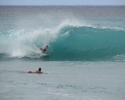Surf Training Products
Wave Pools & Flowboards: The Man Made Wave Sensation
 During our lifelong search of perfect empty waves it was only a matter of time before we dived into the topic of man-made wave pools. The possibilities are endless! Perfect shape, no shoulder hoppers, and no sharp reefs to ruin a surf trip 12 months in the making. SurfScience.com wanted to get familiar with the latest developments in wave pool technology. Here is what we found.
During our lifelong search of perfect empty waves it was only a matter of time before we dived into the topic of man-made wave pools. The possibilities are endless! Perfect shape, no shoulder hoppers, and no sharp reefs to ruin a surf trip 12 months in the making. SurfScience.com wanted to get familiar with the latest developments in wave pool technology. Here is what we found.
During our search we found plenty of kiddie wave pools in which we can splash around, but we didn’t find very many opportunities to surf engineered waves. In fact, many of the wave pools that were around have gone belly up. This includes the Seagaia Ocean Dome, located in Miyazaki, Japan. You may have seen Youtube footage of Julian Wilson and Owen Wright getting pitted in some very pretty waves. This wave pool produced one wave every 20 seconds, making it a very appealing attraction. The hard cement bottom made it very unappealing. That and the fact it was located two blocks from the beach made this a doomed venture, closing its doors October 1, 2007.
Fortunately for all of us, Tom Lochtefeld is one surfer with one mighty sized entrepreneurial spirit. The founder of Raging Waters Water Parks, Lochtefeld also founded the Wave Loch technology that powers the growing sport of FlowRiding. This board sport combines elements of skateboarding, snowboarding and surfing to create an entirely new sensation.
There are now over 110 venues using Wave Loch technology to offer either FlowRider® or FlowBarrel attractions. This includes 50 venues in the United States and unlike the Seagaia Ocean Dome, most are located nowhere near ocean waves. Both the FlowRider and the FlowBarrel employ high powered submersible pumps to shoot a three inch layer of water over a surface designed to replicate the shape of ocean waves.
 According to Marshall Myrman, chief operations officer of Wave Loch, the main goal of the FlowBarrel is to give people the thrill of getting barreled for the first time.
According to Marshall Myrman, chief operations officer of Wave Loch, the main goal of the FlowBarrel is to give people the thrill of getting barreled for the first time.
“Tom wanted people who had never ridden a barreling wave to be able to ride one. Mission accomplished. The product is incredible to ride and people are completely stoked riding it,” says Myrman. “Guys are doing unbelievable tricks; Boosting double layout back flips, guys landing in the pit from eight to ten feet. Just an unbelievable show to watch.”
When asked if Flow Riding translated to surfing, Myrman had an interesting take on the subject.
“It’s like learning a whole new sport, but it does translate. I’m out on the FlowBarrel for about 1-2 minutes each ride and I’m kind of exhausted. Imagine what it would be like to ride a wave for two minutes.”
“You’re riding this really short board, a little bit bigger than a skateboard, against this flow water, getting a great workout,” the Wave Loch executive said. “It makes you focus on edge control. When I hop on a surfboard, I feel like I can ride shorter boards because I’ve been riding a super short flowboard. It really changed my overall perception of surfing to tell you the truth. It really does translate to all board sports.”
It also sounds as if the minds at Wave Loch have given some thought to surfing wave pool technology.
“Utilizing what we have learned from sheet wave technology in building the world’s only true barreling machine, i.e. FlowBarrels, it is our goal to create a mind numbing, behind the bend barrel synonymous with the best barrels in the world,” explains Myrman. “Wave Loch understands all of the elements of the barrel – width, aperture, speed, ability to enter and most importantly, exit – and has defined artificial tube riding. Granted, they may be fresh water, but there is nothing artificial about weaving over a foam ball on a solid six footer. The goal is to create consistent quality barrels, as that is the expectation when you slap the money down!”
Greg Webber, founder of Webber Surfboards, is also looking at new wave pool technology. Although still in the developmental stage, his company’s design that would allow ten different barreling waves to break around a center island. It is called the Liquid Time Wave Pool. According to their website, ten two meter waves break constantly around a circular island within a doughnut shaped pool. The result is a dwarfing of the other pool types in terms of cost, ride length and wave quality.
You had me at hello.
To test this theory, Webber’s team used a fishing trawler in a river to generate chest high ship waves capable of being surfed. Despite imperfect river conditions, the team also produced more powerful, barreling waves. Webber considered this test a success and it motivated him to further explore the idea.
As our local breaks get more crowded and the sport of surfing becomes more popular, you may soon be able to live the surf lifestyle away from the beach. Just think, fewer people, lower cost of living, less traffic…On second thought, SurfScience.com just may pack it up and move to Texas. After all, that state has three FlowRiders.
If you're looking to try a flow rider, check out the Wave House website and find the one closest to you.










0 Comments